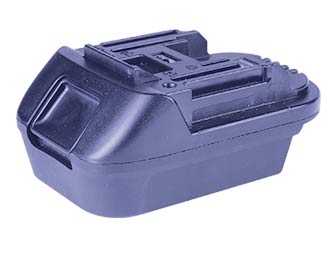In late 2019 a new type of power tool accessory emerged on the internet marketplace. This new power tool accessory, an adapter, is intended to allow power tool battery packs from one manufacturer to be used with another manufacturer’s power tools. While on the surface this seems like a very handy device, it can cause unintended and potentially dangerous consequences, including overheating and even fires. Any time you bypass or work around the manufacturer’s battery packs you put yourself at risk.

Batteries are designed and rigorously tested by power tool manufacturers to operate within their particular power tool system. The system consists of the manufacturer’s battery pack, power tool, and charger. Power tool battery packs contain very high amounts of stored energy and battery pack manufacturers manage this energy storage and release by employing a sophisticated battery management system (“BMS”). The BMS allows electronic communication between system components so that proper charge and discharge levels can be achieved during use. Because each system may be unique, the BMS electronics may exist in the battery, in the power tools, and/or battery chargers. The electronics may also be split amongst the various system components they are designed and intended to be used in. Since battery adapters do not contain the proper electronics, their use may allow the user to bypass the BMS elements contained in tools or chargers, which can create a potentially dangerous situation. The battery, charger and tools of different manufacturers don’t communicate with each other.
For example, a power tool manufacturer may place its discharge protection features inside the power tool, which will function to protect the battery while being used. Since the designers of the system allow the power tool to monitor the condition of the battery to provide discharge protection, protection electronics are not included inside the battery pack. The use of a battery adapter may not allow the power tool to properly determine the battery’s condition, which may not allow it to appropriately protect the battery during discharge.
Similarly, should the adapter be used with a battery pack during a charging cycle, it may not allow for proper overcharge protection. Here, the system designers rely on protection features and communication channels of the BMS located in the battery charger to be present and active during a charging cycle. The use of the battery adapters may bypass important communication channels between the battery pack and charger. This may result in the battery being overcharged, which can lead to overheating and potentially a fire involving the battery pack and/or charger.
While the use of these battery adapters may seem like a good accessory for users of tools, the unintended consequences created by them can easily outweigh the benefits provided. Use only batteries outlined in the power tool manufacturer’s Operator’s Manual (or other tool manufacturer product literature) with your power tool.
THIS DOCUMENT IS PROVIDED BY POWER TOOL INSTITUTE (“PTI”) FOR INFORMATIONAL PURPOSES ONLY. ANY INACCURACY OR OMISSION IS NOT THE RESPONSIBILITY OF PTI. PTI DOES NOT MAKE ANY REPRESENTATIONS OR WARRANTIES WITH RESPECT TO THIS DOCUMENT OR ITS CONTENTS. PTI HEREBY DISCLAIMS ALL WARRANTIES OF ANY NATURE, EXPRESS, IMPLIED OR OTHERWISE, OR ARISING FROM TRADE OR CUSTOM, INCLUDING, WITHOUT LIMITATION, ANY IMPLIED WARRANTIES OF MERCHANTABILITY, NONINFRINGEMENT, QUALITY, TITLE, FITNESS FOR A PARTICULAR PURPOSE, COMPLETENESS OR ACCURACY. TO THE FULLEST EXTENT PERMITTED BY APPLICABLE LAWS, PTI SHALL NOT BE LIABLE FOR ANY LOSSES, EXPENSES OR DAMAGES OF ANY NATURE, INCLUDING, WITHOUT LIMITATION, SPECIAL, INCIDENTAL, PUNITIVE, DIRECT, INDIRECT OR CONSEQUENTIAL DAMAGES OR LOST INCOME OR PROFITS, RESULTING FROM OR ARISING OUT OF A COMPANY’S OR INDIVIDUAL’S USE OF THIS DOCUMENT, WHETHER ARISING IN TORT, CONTRACT, STATUTE, OR OTHERWISE, EVEN IF ADVISED OF THE POSSIBILITY OF SUCH DAMAGES.